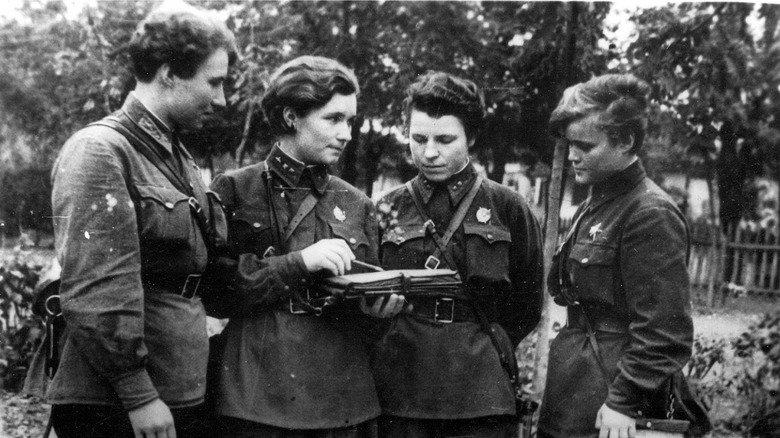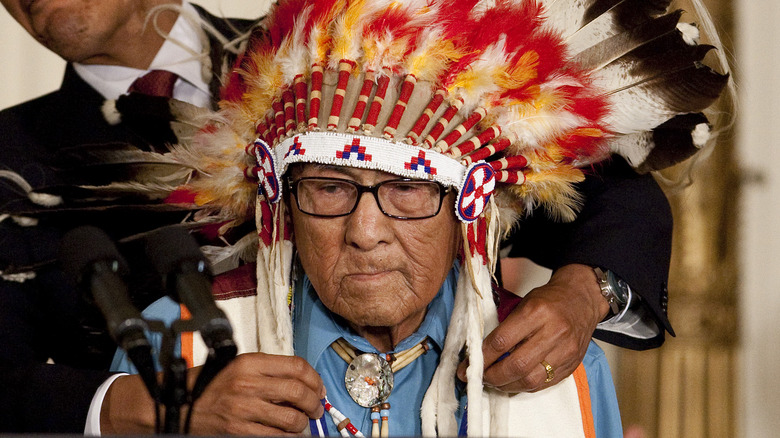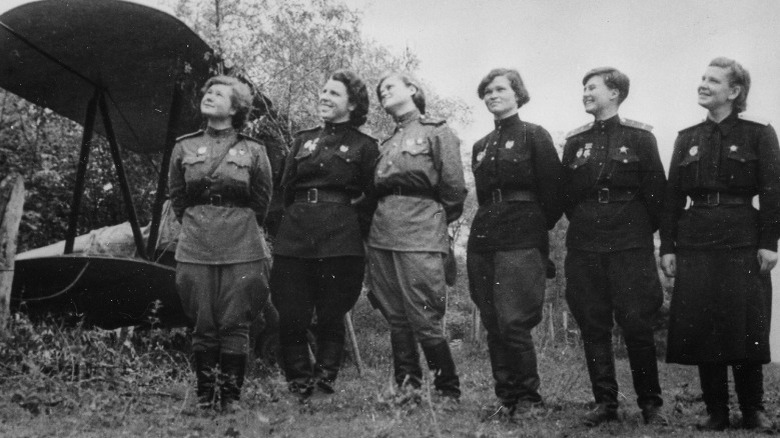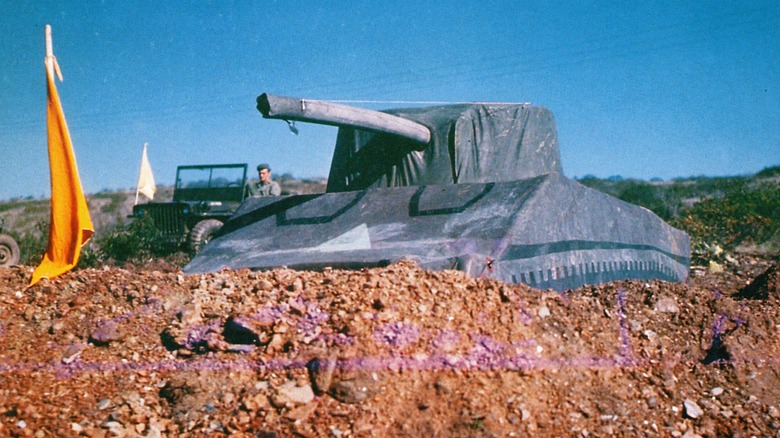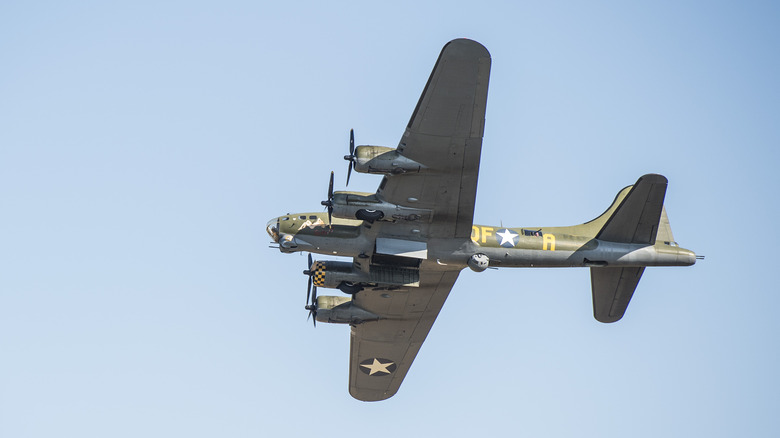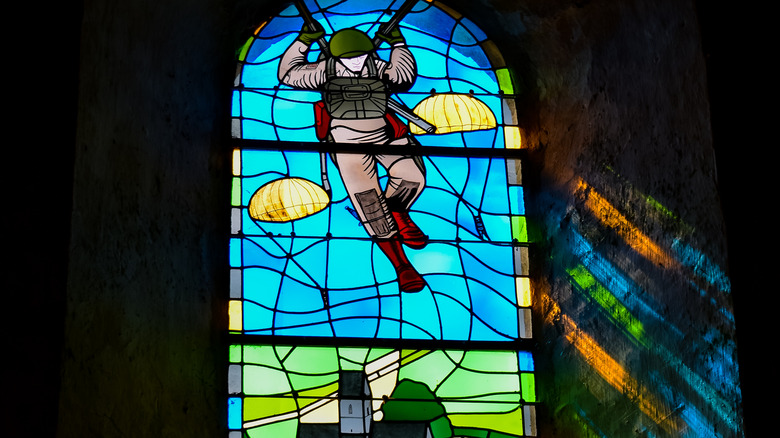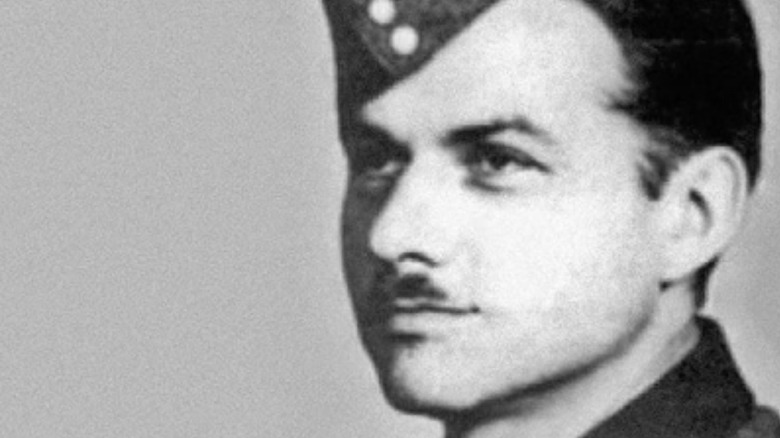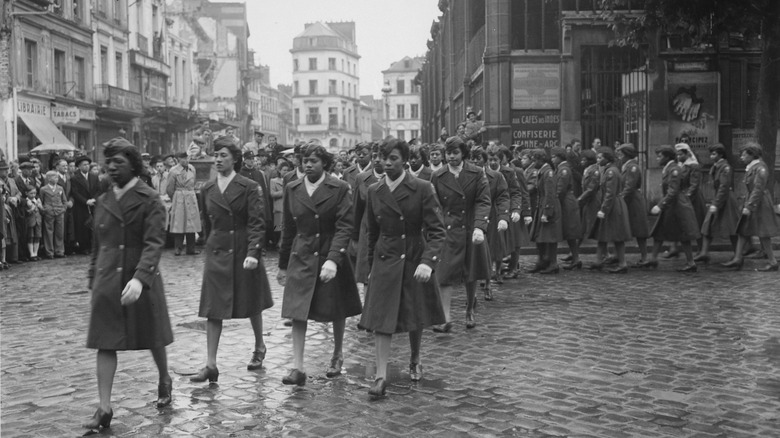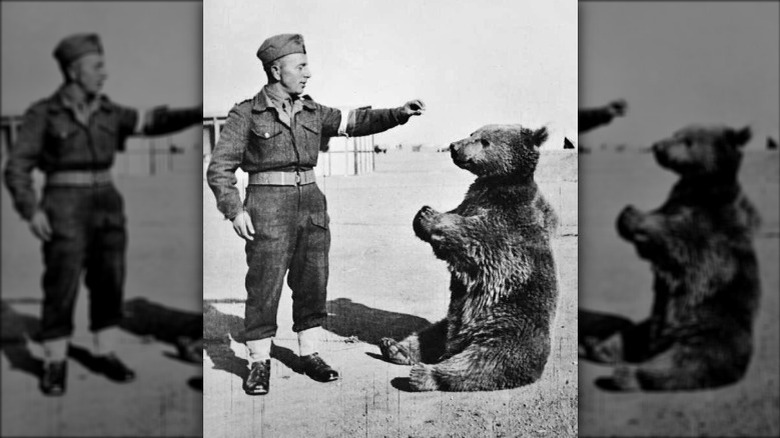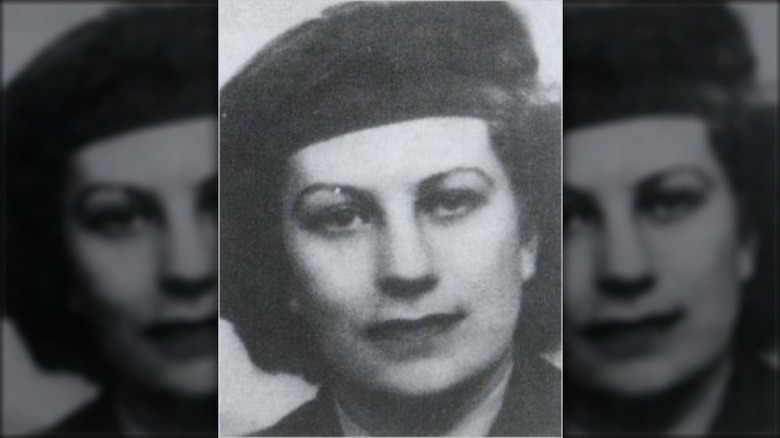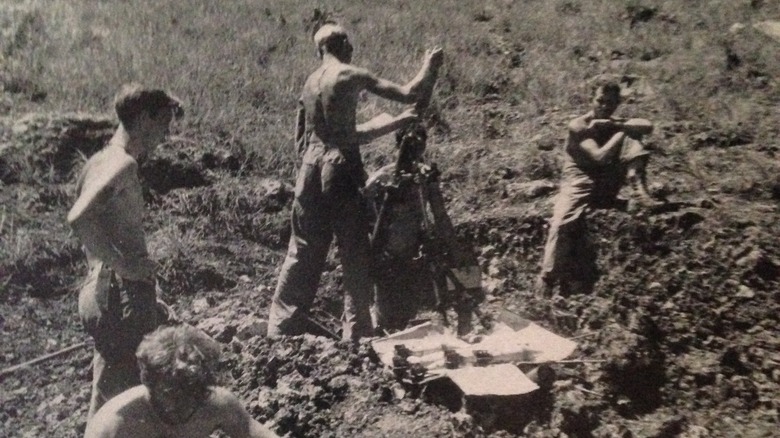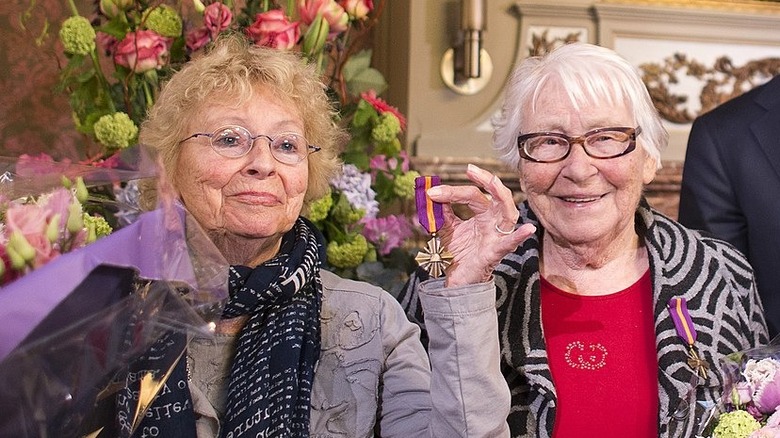Remarkable World War 2 Stories That Deserve A Movie
Whether you're a diehard fan of 2006's "Flags of Our Fathers," obsessed with tearjerkers like 1997's "Life Is Beautiful," or satisfied by the poetic justice of 2009's "Inglourious Basterds," World War II movies continue to place the events of the previous century in greater focus while exploring human nature under extreme circumstances. As new (and old) directors contribute their perspectives on this conflict, our knowledge of the cataclysmic events of the 1930s and 1940s keeps expanding.
Despite all the Hollywood treatment to date, however, plenty of fascinating incidents from the war years still haven't received the coverage they deserve. In some cases, these are also some of the most shocking and outlandish tales from the war. They include everything from a bear who went into battle to an all-female squadron of pilots who menaced Eastern Front skies with radar-evading biplanes.
Of course, truth always proves stranger than fiction. Nowhere is this more evident than the following events. So, come along for the ride as we explore the most remarkable stories of World War II yet to receive silver screen treatment.
The Crow warrior who became a WWII war chief
Ken Burns profiled Joe Medicine Crow in his documentary "The War." But surprisingly, no mainstream movie has showcased this incredible war hero and his unfaltering bravery. Yet, it's hard to beat the tales of heroism that not only helped him prevail against the Nazis but also permitted him to become the last "War Chief of the Crow Indians," per Military.
To earn this incredible honor, Medicine Crow completed the Four Feats of Valor, a series of challenges dating back to the introduction of horses into North America by the Spanish Conquistadors. Yet, he did so during a conflict defined by automatic weapons, tanks, airplanes, and eventually nukes. These Four Feats included: making contact with an enemy without killing him, leading a war party to success on the battlefield, seizing a combatant's weapon, and stealing one or more horses from an enemy.
Fortunately, he nailed two of the feats at the same time after literally running into a Nazi soldier whom he wrestled to the ground and disarmed. He led what looked like a suicide mission with a group of men to seize explosives from behind enemy lines without losing a man. And he even snuck into a Nazi encampment, making away with a herd of horses while singing a Crow war song. How there's no movie about Medicine Crow featuring big-name celebs is hard to fathom. Wake up, Hollywood!
The Night Witches
The all-female 588th Night Bomber Regiment out of the Soviet Union struck terror into the hearts of German soldiers, per the Wright Museum. Nazis who encountered these women faced "the soft 'whooshing' of the wind off the struts of a 'Night Witch' jerry-rigged biplane bomber ... described as the eerie sound of a witch's broom as it quietly glided in to drop its payload of bombs."
The heroines of the 588th flew 1920s-era Polikarpov Po-2 biplanes crafted from canvas and wood. Known fondly as "Stalin's Falcons," the women nicknamed their biplanes "flying coffins" because they tended to burst into flames when struck by tracer fire. The outdated planes also came with plenty of limitations. Pilots had to go on nighttime raids because the planes flew so low, and top speeds bottomed out at 90 mph. The aircraft carried just one bomb under each wing, and they didn't bring parachutes, keeping weight to a minimum. Instead of modern aviation instruments, they relied on pencils, stopwatches, flashlights, maps, and compasses, flying in open cockpits unshielded from the elements.
Yet, the "Night Witches" dropped more than 23,000 tons of incendiaries on Nazi targets, becoming an indispensable asset to the Soviet war machine (via History). What's more, their aging planes also came with a couple of advantages. Their wood and canvas structures evaded radar, and their slow speed made it hard for German pilots to engage them without stalling out.
The Ghost Army
No other unit compared to the 23rd Headquarters Special Troops, per Task and Purpose. Comprised of 1,100 illustrators, artists, and radio and sound guys, they relied on misinformation and fakery to deceive the enemy (via Smithsonian Magazine). Known as the "Ghost Army," their bag of tricks included misleading radio transmissions and inflatable tanks (via Ghost Army Legacy Project). Their efforts paved the road for an Allied advancement, albeit through bamboozling.
That said, underestimating this con artist army, whose heaviest weapons were .50 caliber machine guns, came with serious consequences. Their impact on the battlefield often proved far greater than that of much larger units. The 23rd pulled this off by remaining small enough to maneuver quickly while specializing in the imitation of larger forces. For example, they could easily convince the Germans they were two divisions, quelling enemy advances before they started.
Each of the four units within the "Ghost Army" served a specific function. The 603rd Camouflage Engineer Battalion supplied inflatable planes, artillery pieces, tanks, and other physical props. The 3132 Signal Service Company provided sound effects to support these visuals. The 406th Combat Engineers Company excavated inflatable emplacements, provided security, and peddled counterfeit division patches to throw off German collaborators and spies. Finally, the Signal Company Special created and transmitted radio traffic to confuse the enemy. Although there's an eponymous PBS documentary about the army, it remains the ideal material for a major movie. (According to IMDb, Ben Affleck has one in pre-production as of 2022.)
The unlikely airborne hero
Most interactions between Nazi flying aces and compromised American bomber crews didn't turn out well. But then there's the unlikely story of American B-17 bomber pilot Charlie Brown and his crewmates (via the New York Post). On their inaugural mission, which involved disabling a munitions factory in Germany in 1943, 15 German planes attacked Brown's B-17, spelling almost certain doom.
In the attack, one of his crew members died instantly, and six others sustained injuries. The three remaining men had their hands full, rendering first aid to their comrades. Brown lost consciousness, reviving only just in time to avoid a fatal nosedive. By anyone's estimation, Brown and his crew were goners. But then the improbable occurred.
According to footage of an interview given years later, a German flying ace named Franz Stigler came up beside the plane. Although allegiance bound him to destroy the B-17, he could not. Instead, he escorted the wreck of a plane back towards safety and friendly airspace before giving a salute and taking off. Stigler acted mercifully because he felt it dishonorable to shoot down an indefensible plane. Years later, Stigler and Brown reunited and became good friends. They died six months apart in 2008 and listed one another as "a special brother" in their obituaries. (You might not have to wait too long to see this story brought to life on the silver screen. The movie "A Higher Call" is listed in development as of 2022.)
The paratrooper medics that saved a town
On June 6 and 7, 1944, Angoville-au-Plain, France became ground zero for vicious World War II combat (via Larry Alexander's "In the Footsteps of the Band of Brothers: A Return to Easy Company's Battlefields With Sergeant Forrest Guth"). Boasting 42 residents, Angoville-au-Plain's biggest claim to fame remained a 900-year-old Norman church. But the hamlet quickly garnered a spot in war history annals as American paratroopers and German soldiers faced off. Three times the town swapped allegiances in a few gruesome hours.
But medical treatment by two American paratroopers and medics, Robert Wright and Kenneth Moore, never stopped despite the barrage, as reported by the Gwinnett Daily Post. The two men worked night and day in the village church while fighting carried on around them, saving the lives of countless people. Their patients included German and American troops alike, winning them protection from both sides. Wright, 20, and Moore, 19, even faced abandonment behind enemy lines: "Our own folks had come to tell us that they could not stay any longer. So we were left alone with the wounded soldiers," per Alexander's book.
Soon, the medics cared for 75, including individuals from both sides and civilians caught in the fray. Today, the Norman church where they sought refuge contains stain-glassed windows commemorating the two medics' bravery. A documentary from 2013 entitled "Eagles of Mercy" delves into their story, as do numerous books. But we're still rooting for a big-screen adaptation of this incredible story.
The interrogator that killed them with kindness
What could the FBI learn from a World War II-era German interrogator? Quite a lot, according to the Los Angeles Times. Meet Hanns Scharff from South Africa, conscripted into the Luftwaffe as an English interpreter and interrogator. After getting assigned to Allied pilot interrogations, he witnessed an ugly instance of prisoner abuse. Secretly, he swore to do things differently. And when the opportunity arose, he held true to his word.
Instead of brutality, he engaged prisoners in friendly chats and showed them respect and even empathy. Scharff got results despite what some considered a "soft" approach to enemy dealings. The art-student-turned-interrogator "happened upon some of the strategies that are really effective, and we are beginning to understand why they are effective and how effective they can be," explains Christian Meissner, an Iowa State University psychology professor.
His approach, which even involved sharing homemade baked goods from his wife, remains superior to other techniques, yielding better and more accurate information, as Pacific Standard notes. Of the 500 allied pilots Scharff questioned, he gained valuable information from all but 20, reports the Los Angeles Times. That's impressive considering each of these pilots received the same training when it came to divulging nothing beyond their names, serial numbers, and ranks. Scharff knew how to kill them with kindness, and he remains one of the "most esteemed of all wartime interrogators" according to the National Defense Interrogation College's "Interrogation: World War II, Vietnam, and Iraq."
A groundbreaking army corps
The U.S. 6888th Central Postal Directory Battalion (the SixTripleEight) was the first all-black and all-female army corps stationed abroad during World War II, according to Women of the 6888th. These brave ladies ensured the delivery of letters to almost 7 million troops across war-torn Europe, facing harrowing obstacles along the way (via Army History). Created in 1942, the battalion worked diligently, remaining true to their motto, "No mail, low morale."
Despite focusing behind the lines on the mail, the women of the battalion faced real physical risks. These included German U-boat threats to their convoy on the way to Europe. Upon arrival, a German V1 rocket or "Buzz Bomb" nosedived the area where they disembarked from the ship, forcing the women to flee for cover. Fortunately, no one was injured.
Some 855 women served in the SixTripleEight under the direction of Major Charity Adams in Birmingham, England; Rouen, France; and finally Paris, France. Tasked with tackling many years' worth of backlogged mail on the Continent, they worked out of dirty, dank, and rat-infested warehouses and aircraft hangars. Although they had six months to complete their assignment, the women did it in half the time. According to Audacy, a monument at Fort Leavenworth commemorates the brave women of this unit, as does a 2019 documentary called "The SixTripleEight." This story has movie magic written all over it.
The bear who went to war
During the summer of 1942, the Polish army evacuated to Iran to join the British Middle East Command, per YouTube. In Hamadan, they found a Syrian brown bear cub that needed rescue (via The Washington Post). The Polish brought the weak cub back to a nearby refugee camp, and soldiers from the 22nd Artillery Supply Company soon took responsibility for the furry little guy.
They named him Wojtek (meaning "happy warrior"), and he fit right in, mimicking the troops' behavior and boosting morale. Wojtek soon represented the unofficial mascot of the 22nd company, relocating with them as they marched west to join up with British forces at the Battle of Monte Cassino. Eventually, the Polish troops made it to the frontlines, providing vital artillery support. But the 22nd struggled under constant, heavy fire. That's when Wojtek came to the rescue, carrying crates of artillery shells that typically required four men to move into position. For his bravery in battle, the friendly bear got promoted to corporal and was made the official emblem of the company.
Following demobilization at the end of the war, Wojtek ended up stationed in Scotland with his Polish comrades. Eventually, he retired to the Edinburgh Zoo, where former members of the 22nd often visited him. According to the BBC, a documentary about the life of Wojtek exists. So does an animated film, per The First News. But if this story doesn't scream "Hollywood adaptation," we don't know what does.
The unexpected heroine
On September 2, 2010, an obscure 89-year-old woman named Eileen Nearne died in Torquay, England, per the New York Times. Without close friends or family to claim her remains, Nearne faced burial in a pauper's grave, according to War History Online. But then local police searched her possessions and came across a stunning discovery. The nearly anonymous woman possessed a Croix de Guerre (Cross of War) from the French government, and King George VI had appointed her a Member of the Order of the British Empire (MBE).
A little more digging revealed her role as a secret agent recruited by the British Special Operations Executive (SOE) because of her impeccable French mastery. After field training, she parachuted onto the Continent, assisting the French Resistance during the Nazi occupation. Nearne went by many names, including Jacqueline Duterte and Mademoiselle du Tort. But "Rose" remained her official codename, as reported in Paul Beck's "Heroes of World War II." During her time in France, Nearne helped to create a resistance network known as "The Wizard." She also provided vital information to the Allies in the ramp-up to D-Day (via the Los Angeles Times).
After surviving several near misses, the German secret police captured and tortured her. But she refused to give up information. Several Nazi concentration camps later, she and two French women escaped. Although Nearne appeared in the 1947 documentary "Now It Can Be Told," this British agent has yet to have an A-lister act out her life story.
Beyond the call of duty at Guadalcanal
On September 12 and 13, 1942, a Japanese force 2,000 strong attacked Henderson Field at Guadalcanal, Solomon Islands, as reported by Government Attic. Major Kenneth Dillon Bailey commanded Company C, 1st Marine Raider Battalion, to oppose the enemy threat (via the Congressional Medal of Honor Society). Bailey outmaneuvered the attackers, incrementally improving his troops' positioning, even as Company C provided cover to the main line withdrawal. In the process, they expended their weapons supply. Soon, they faced a punishing assault while vastly outnumbered, and yet they held the line.
Despite a severe head wound, Bailey's service didn't stop there. Instead, he reorganized the company after its retreat and continued to lead his men for 10 excruciating hours in the face of brutal hand-to-hand combat. Despite a near-constant barrage of enemy gunfire, he buoyed his troops' spirits and inspired them to individual acts of valor. His effort prevented the seizure of Henderson Field.
Sadly, Bailey died 13 days later while leading an assault on the Japanese at Matanikau River, Guadalcanal. After his death, he received the Medal of Honor for "extraordinary courage and heroic conduct above and beyond the call of duty," according to the Naval History and Heritage Command. While the Navy Destroyer USS Kenneth D. Bailey is named after him, his story has yet to receive the film attention it deserves.
Defending Pavlov's House
Countless stories of heroism have come out of the Battle of Stalingrad, per War History Online. They include the tale of Vasili Zaitsev, the famed sniper commemorated in 2001's "Enemy at the Gates." But another worthwhile episode of Soviet resistance to the Nazis happened at "Pavlov's House."
In the summer of 1942, the German Sixth Army stormed into Stalingrad. These invaders hoped to sever Soviet supply lines located along the Volga River, considered "the very heart of Russia," according to Brian Moynahan's "Forgotten Soldiers." What's more, they hoped to bring the Soviet Union to its knees by hamstringing one of the nation's chief industrial metropolises. Their plan looked unstoppable. Soon the Germans possessed a shocking 90% of Stalingrad.
With supplies to the city under constant bombardment by Nazi artillery, Sergeant Yakov Pavlov and a group of brave men decided to act, setting up a strategic location in an apartment building, which they fortified to defend a vital section of the Volga River. Not only did the building afford excellent views of the surrounding area, but it provided a "protective buffer" for a supply area located along the Volga River's shore. For the next two months, Pavlov and his men, assisted by reinforcements, held the key position, killing countless German soldiers in the process. From their rooftop position on the fortified apartment building, Pavlov and his men even found ways to disarm Nazi tanks via the thin armor on their roofs.
The teen cyclists that slayed Nazis
Despite their appearance of wholesome, curly-haired teens, the Dutch sisters Freddie, 14, and Truus Oversteegen, 12, represented lethal threats to Nazi officers occupying the Netherlands (via History). Behind the scenes, the girls worked for the Dutch Resistance, moving through the ranks from arsonists to assassins, according to The Guardian. They also worked as saboteurs, targeting essential bridges and rail lines when needed.
Where did these two school-aged girls get their courage? According to Jeroen Pliester of the National Hannie Schaft Foundation, "I think that was one of the main drivers for them, the high moral principle and preparedness of their mother to act when it really matter[ed]" (as quoted by History). Their mother, Trijn, sheltered those hunted by the Nazis, including Jews, homosexuals, and political dissidents, despite obvious personal risks (per The Guardian).
Over time, the girls brought their friend Hannie Schaft into their fold, and she developed a reputation as the infamous "girl with the red hair" by Nazi soldiers. After the Germans captured and executed Schaft, the reality of the dangers the Oversteegens faced came into sharp reality. Yet, their heroics continued. A 2016 documentary tells their story, and a television series entitled "Rebels: The Oversteegen Sisters Story" is in development as of 2022.
